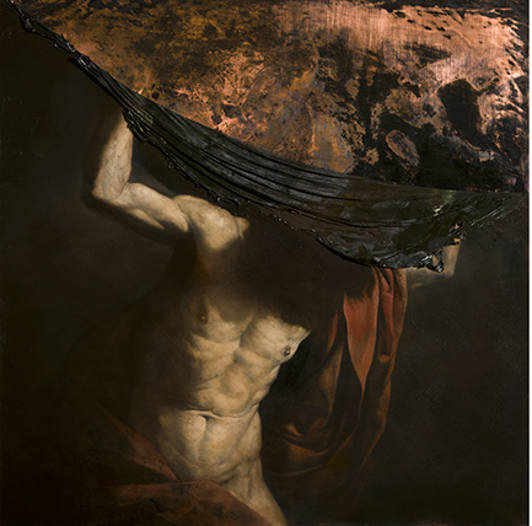Nicola Samori'
dal 17/1/2015 al 21/3/2015
Segnalato da
17/1/2015
Nicola Samori'
Trafo Trafostacja Sztuki, Center for Contemporary Art, Szczecin
Religo. Working with precisely composed paintings and sculptures, the artist creates figurative pieces characterized by a high degree of complexity and technical virtuosity. With a site-specific installation in St. John the Evangelist Church.

Curator Marie-Eve Lafontaine
TRAFO Center for Contemporary Art is pleased to present Poland’s first comprehensive institutional exhibition devoted to the art of Nicola Samorì (born in 1977 in Forli). Working with precisely composed paintings and sculptures, the Italian artist Nicola Samorì creates figurative pieces characterized by a high degree of complexity and technical virtuosity. Combining a sense-penetrating intensity inspired by the theatrical aesthetics of Renaissance and Baroque art with modern references to the gesture-led field of post-war expressionist painters, Samorì’s meticulously painted compositions, hand carved marble sculptures and shimmering abstract canvasses reflect on the role of art history and the figurative form in visual art today.
In RELIGO, Samorì’s work acts as a lens through which the viewer can examine the modern impact of religious symbolism on Western aesthetics. The word, which derives from the Latin “re-ligare”, means to re-bind or re-connect, and emphasizes the religious and historical roots of Samorì’s artworks, referencing a time when spirituality and culture were closely connected.
In approaching the surfaces of his paintings as a material skin, Samorì puts his compositions through an aggressive physical transformation. As the work undergoes deconstruction it is pushed over the boundary of the strictly 2D and enters the viewer’s space. In a distinctly contemporary twist, these alterations express an inner narrative and heighten the theatricality of the original subject matter. In other paintings Samorì continues to experiment with abstract and “hidden” compositions in copper, gold, and silver, which draw in part from the visual traditions of Byzantine icons. In his site-specific installation at TRAFO, Samorì references the history of religious symbolism as well as the wide variety of historical and aesthetic influences which come together in a given work of contemporary art. In revealing subjective perceptions in the viewer’s own approach to personal belief, Samorì’s installation is not only a forceful reminder of the very pagan roots of modern religion, but is also an examination of modern personal religious practices, or lack thereof, and its reverberations in contemporary art today.
For the first time ever in Poland, the show will unite three series of works within a solo exhibition. Furthermore, TRAFO has commissioned a site-specific installation for its main hall and an oil painting to be exhibited within the neighboring St. John the Evangelist Church. The purpose of this collaboration is to encourage dialogue about the division of contemporary culture and religion. Visitors are invited to view the work during church opening times.
Nicola Samorì (born in Forli in 1977), lives and works in Bagnacavallo near Ravenna, Italy. He attended the Accademia di Belle Arti in Bologna from which he graduated in 2004. His early exhibitions include: “Dei Miti Memorie” (Central TAFE Gallery, Perth, 2003), “Sine Die” (Museo d’Arte Contemporanea, Gibellina, 2007), “Arte Italiana 1968-2007. Pittura” (Palazzo Reale, Milan, 2007) and the 9th Premio Cairo (Palazzo della Permanente, Milan, 2008). His exhibition “La Dialettica del Mostro” (Galleria Marcorossi Artecontemporanea, Milan, 2010) introduced wa new direction towards incorporations, in which the image is altered and rewritten. In the same year he began to open up his compositions by physically deconstructing the painted surface, and in addition to being invited to participate in the 54th Venice Biennale, (Italian Pavilion Arsenale, Venice, 2011) he had solo shows in Berlin (“Imaginifragus”, Christian Ehrentraut Gallery, 2012) and New York (“The Venerable Abject”, Ana Cristea Gallery, 2012).
Works of recent years came together in “Fegefeuer” (Kunsthalle Tübingen, 2012), his first museum exhibition abroad, and in “Die Verwinding”, the artist’s first solo exhibition at the Galleria Emilio Mazzoli in Modena. His second solo exhibition at Christian Ehrentraut Gallery, “Guarigione dell’Ossesso” (2013) included a series of images that dealt with themes of disillusionment. Solo and group exhibitions took place in 2014 at Schauwerk in Sindelfingen, at Palazzo Chiericati in Vicenza, at MAC in Lissone, at the Kunsthalle in Kiel and at Rosenfeld Porcini Gallery in London.
Immagine: Volta del Mondo, 2014, oil on copper
Press contact
Anna Konopka phone: +48 885 065008 e-mail: anna.konopka@trafo.org
Public Opening: January 17, 2015 at 7.00 p.m.
TRAFO Trafostacja Sztuki, Center for Contemporary Art
4 Świętego Ducha st. 70-205 Szczecin Poland
Hours: all days 11 a.m. - 7 p.m.
monday closed



